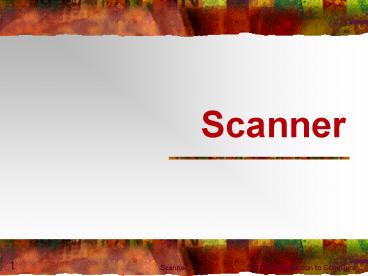Scanner - PowerPoint PPT Presentation
Title:
Scanner
Description:
How to construct a scanner Define tokens in the source language. Describe the patterns allowed for tokens. Write regular expressions describing the patterns. – PowerPoint PPT presentation
Number of Views:44
Avg rating:3.0/5.0
Title: Scanner
1
Scanner
2
Outline
- Introduction
- How to construct a scanner
- Regular expressions describing tokens
- FA recognizing tokens
- Implementing a DFA
- Error Handling
- Buffering
3
Introduction
- A scanner, sometimes called a lexical analyzer
- A scanner
- gets a stream of characters (source program)
- divides it into tokens
- Tokens are units that are meaningful in the
source language. - Lexemes are strings which match the patterns of
tokens.
4
Examples of Tokens in C
Tokens Lexemes
identifier Age, grade,Temp, zone, q1
number 3.1416, -498127,987.76412097
string A cat sat on a mat., 90183654
open parentheses (
close parentheses )
Semicolon
reserved word if IF, if, If, iF
5
Scanning
- When a token is found
- It is passed to the next phase of compiler.
- Sometimes values associated with the token,
called attributes, need to be calculated. - Some tokens, together with their attributes, must
be stored in the symbol/literal table. - it is necessary to check if the token is already
in the table - Examples of attributes
- Attributes of a variable are name, address, type,
etc. - An attribute of a numeric constant is its value.
6
How to construct a scanner
- Define tokens in the source language.
- Describe the patterns allowed for tokens.
- Write regular expressions describing the
patterns. - Construct an FA for each pattern.
- Combine all FAs which results in an NFA.
- Convert NFA into DFA
- Write a program simulating the DFA.
7
Regular Expression
- a character or symbol in the alphabet
- an empty string
- an empty set
- if r and s are regular expressions
- r s
- r s
- r
- (r )
l
f
8
Extension of regular expr.
- a-z
- any character in a range from a to z
- .
- any character
- r
- one or more repetition
- r ?
- optional subexpression
- (a b c), abc
- any single character NOT in the set
9
Examples of Patterns
- (a A) the set a, A
- 0-9 (0 1 ... 9) (0 1 ... 9)
- (0-9)? (0 1 ... 9 )
- A-Za-z (A B ... Z a b ... z)
- A . the string with A following by any one
symbol - 0-9 0123456789 any character which is
not 0, 1, ..., 9
l
10
Describing Patterns of Tokens
- reservedIF (IF if If iF) (Ii)(Ff)
- letter a-zA-Z
- digit 0-9
- identifier letter (letterdigit)
- numeric (-)? digit (. digit)? (E (-)?
digit)? - Comments
- ()
- / (/) /
- (newline) newline
11
Disambiguating Rules
- IF is an identifier or a reserved word?
- A reserved word cannot be used as identifier.
- A keyword can also be identifier.
- lt is lt and or lt?
- Principle of longest substring
- When a string can be either a single token or a
sequence of tokens, single-token interpretation
is preferred.
12
FA Recognizing Tokens
- Identifier
- Numeric
- Comment
/
13
Combining FAs
- Identifiers
- Reserved words
- Combined
14
Lookahead
letter, digit
I,i
F,f
Return ID
other
Return IF
15
Implementing DFA
- nested-if
- transition table
16
Nested IF
- switch (state)
- case 0
- if isletter(nxt)
- state1
- elseif isdigit(nxt)
- state2
- else state3
- break
- case 1
- if isletVdig(nxt)
- state1
- else state4
- break
letter, digit
other
1
4
letter
digit
0
2
other
3
17
Transition table
St ch 0 1 2 3
letter 1 1 .. ..
digit 2 1 .. ..
3 4
..
letter, digit
other
1
4
letter
digit
0
2
other
3
18
Simulating a DFA
- initialize current_statestart
- while (not final(current_state))
- next_statedfa(current_state, next)
- current_statenext_state
19
Error Handling
- Delete an extraneous character
- Insert a missing character
- Replace an incorrect character by a correct
character - Transposing two adjacent characters
20
Delete an extraneous character
E
.
digit
digit
,-,e
,-,e
digit
E
error
digit
digit
digit
21
Insert a missing character
E
.
digit
digit
,-,e
,-,e
digit
E
,-,e
digit
digit
digit
error
22
Replace an incorrect character
E
.
digit
digit
,-,e
,-,e
.
digit
E
digit
digit
digit
error
23
Transpose adjacent characters
gt
error
Correct token gt
24
Buffering
- Single Buffer
- Buffer Pair
- Sentinel
25
Single Buffer
forward
begin
found
reload
The first part of the token will be lost if it is
not stored somewhere else !
26
Buffer Pairs
reload
A buffer is reloaded when forward pointer reaches
the end of the other buffer.
Similar for the second half of the buffer.
Check twice for the end of buffer if the pointer
is not at the end of the first buffer!
27
Sentinel
For the buffer pair, it must be checked twice for
each move of the forward pointer if the pointer
is at the end of a buffer.
sentinel
Using sentinel, it must be checked only once for
most of the moves of the forward pointer.































